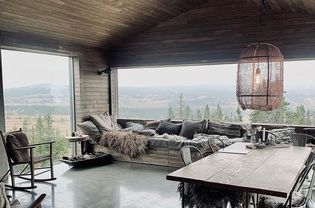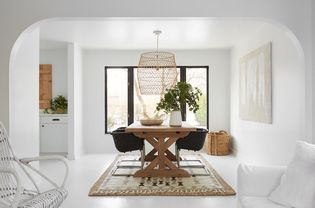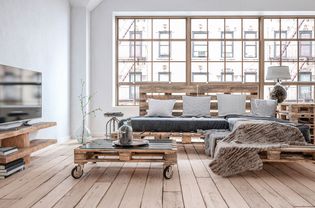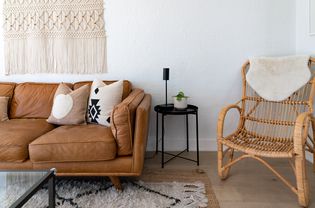As far as trends go, the Boho Farmhouse style has plenty of elements we love—a refreshing twist on old classics, pops of color, and layers of fringe. It’s the perfect look for people who either want to love the Farmhouse look but wish it was more fun, or for those who long to embrace Boho style but feel it’s a little bit too much of a commitment.
We turned to the experts to ask what they love about Boho Farmhouse—a happy marriage of two much-loved home styles.
1. You Can Build on What You Already Have
As Liz of Within the Grove pointed out, the elements of each design are similar enough that blending them together doesn't require too much of an overhaul if your home already features farmhouse decor.
“We've seen Farmhouse taking over the interior design industry and personal homes for years now. People are wanting a change,” she said. “By incorporating Boho[style], it allows for a change in their home design while being able to use a lot of the design elements they currently have. In other words, they don't have to start over from a blank slate.”
If you’re trying to decide what elements you need, then Liz has you covered. She suggests starting with a base of natural wood. “Within both styles, you're going to see how natural wood plays a huge factor in the overall design.”
Be sure to consider “the type of wood; like rustic, whitewashed, or white oak, and how its uses differentiate the two styles,” recommends Liz. Then, incorporate things like “houseplants, texture, and pops of color."
Liz suggests focussing on "earthy tones such as deep olive green, navy, and mustard yellow.” These can easily be incorporated through textiles and home decor pieces.
2. Resilient but Soft
The team at Handmade Charlotte pointed out that the blend of Boho Farmhouse makes for a fun look that’s also incredibly resilient. The heart of the Farmhouse aesthetic is purposefully tough and practical but, here, the Boho style comes in and softens that up.
Best of all, “we especially love that patterned rugs and wallpaper can be really forgiving when it comes to daily wear and tear,” says the team. As you add your Boho elements, they recommended thinking about “anything bold, colorful, or high contrast!”
4. It’s a Kid-Friendly Style
The Handmade Charlotte team also pointed out that all the layers of Boho Farmhouse make it inherently kid-friendly. “It's a great way to easily work in fun, kid-friendly accents like bright pops of color, kid-made art, and playful patterns. It doesn't take itself too seriously and that's super appealing when you have kids in the house.”
Best of all, they suggest, is that these elements can also “help disguise any of those inevitable marks or stains that kids can leave behind.”
5. Everything Old Is New Again
To fully embrace the Boho Farmhouse style, it’s practically a requirement that you incorporate a few vintage pieces.
Paul Middlemiss of the online vintage marketplace Merchant and Found said, “Vintage furniture is a big part of this look, [and] customers no longer just want to buy a piece of furniture, they want a piece with a history and a story.”
You can find the perfect pieces at flea markets or in antique shops, or you can really dive into history and invest in pieces through specialty collectors or retailers.
“Provenance is key,” said Paul. “Championing forgotten makers, researching pieces, scouring old production catalogs, and piecing together the fascinating design history of desirable vintage pieces” is all a part of the process and can elevate your Boho Farmhouse interiors to a whole new level.
6. It’s Perfect for the Eco-Conscious
Paul also pointed out that, if done correctly, Boho Farmhouse is the perfect aesthetic for the eco-conscious. He explains that it's all about the familiar, and, because of the blended nature of these two styles, you’re not limited to a certain look in the way you might be if you’re just focusing on one or the other. “Patina, texture, color, anything goes,” he suggests.
This makes it easier to source used or vintage pieces or to upcycle your own items. “Why buy a mass-produced item, with all the environmental costs involved in manufacturing and transport, when it is possible to save a beautiful thing that already exists?”

:max_bytes(150000):strip_icc()/3H6A5132-scaled-7f80e88d9d1c4e6f9c046c648c8a1ec5.jpg)




